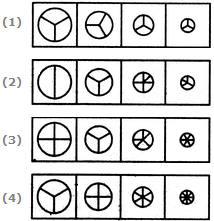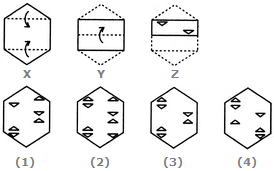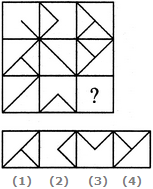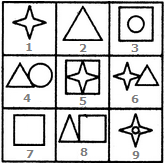Discussion
Home ‣ Non Verbal Reasoning ‣ Cubes and Dice See What Others Are Saying!
- Question
- Four views of one cube are given below. Each of the six faces of cube is numbered. In figure 3 which number will be opposite to the face with number 3?
Options- A. 1
- B. 2
- C. 5
- D. 6
- Correct Answer
- 1
ExplanationAs per the given pattern in question figure , we can find the similar next position of given dice .
The numbers 2, 4, 5 and 6 are on the adjacent faces of the number 3.
Therefore, 1 lies opposite 3. - 1. In a solid cube which is made up of 27 small cubes, two opposite sides are painted red, two painted yellow and the other two with white. How many cubes have two colours?
Options- A. 8
- B. 12
- C. 16
- D. 24 Discuss
- 2. Choose the figure which is different from the rest.
 (1) (2) (3) (4) (5)
(1) (2) (3) (4) (5)
Options- A. 1
- B. 2
- C. 3
- D. 4
- E. 5 Discuss
- 3. Select the alternative in which the specified components of the key figure (X) are found.

Options- A. 1
- B. 2
- C. 3
- D. 4 Discuss
- 4. Choose the set of figures which follows the given rule.
Rule: As the circle decreases in size, its sectors increase in number.

Options- A. 1
- B. 2
- C. 3
- D. 4 Discuss
- 5. Identify the figure that completes the pattern.
 (X) (1) (2) (3) (4)
(X) (1) (2) (3) (4)
Options- A. 1
- B. 2
- C. 3
- D. 4 Discuss
- 6. Choose a figure which would most closely resemble the unfolded form of Figure (Z).

Options- A. 1
- B. 2
- C. 3
- D. 4 Discuss
- 7. Select a suitable figure from the four alternatives that would complete the figure matrix.

Options- A. 1
- B. 2
- C. 3
- D. 4 Discuss
- 8. Select the alternative which represents three out of the five alternative figures which when fitted into each other would form a equilateral triangle.

Options- A. 234
- B. 123
- C. 345
- D. 235 Discuss
- 9. Choose the figure which is different from the rest.
 (1) (2) (3) (4) (5)
(1) (2) (3) (4) (5)
Options- A. 1
- B. 2
- C. 3
- D. 4
- E. 5 Discuss
- 10. Group the given figures into three classes using each figure only once.

Options- A. 3,4,9 ; 5,7,8 ; 1,2,6
- B. 1,5,6 ; 2,4,8 ; 3,7,9
- C. 4,6,8 ; 3,5,7 ; 1,2,9
- D. 1,2,7 ; 3,5,9 ; 4,6,8 Discuss
More questions
Correct Answer: 12
Explanation:
Correct Answer: 3
Explanation:
All other figures contain a geometrical figure along with its mirror image.
Correct Answer: 4
Correct Answer: 4
Correct Answer: 3
Explanation:

Correct Answer: 3
Correct Answer: 2
Explanation:
The third figure in each row comprises of parts which are not common to the first two figures.
Correct Answer: 123
Explanation:

Correct Answer: 4
Explanation:
Except fig. (4), in all other figures, the elements are arranged in the increasing order of the number of sides sequentially, either in a CW or in an ACW direction.
Correct Answer: 1,2,7 ; 3,5,9 ; 4,6,8
Explanation:
1, 2, 7 are simple geometrical figures.
3, 5, 9 have one element placed inside a different element.
4, 6, 8 have two different elements attached to each other.
Comments
There are no comments.Programming
Copyright ©CuriousTab. All rights reserved.
